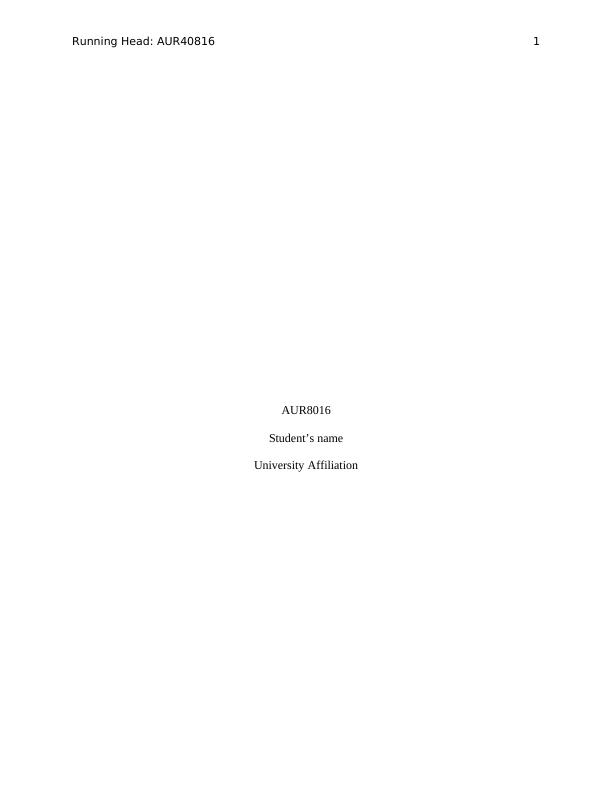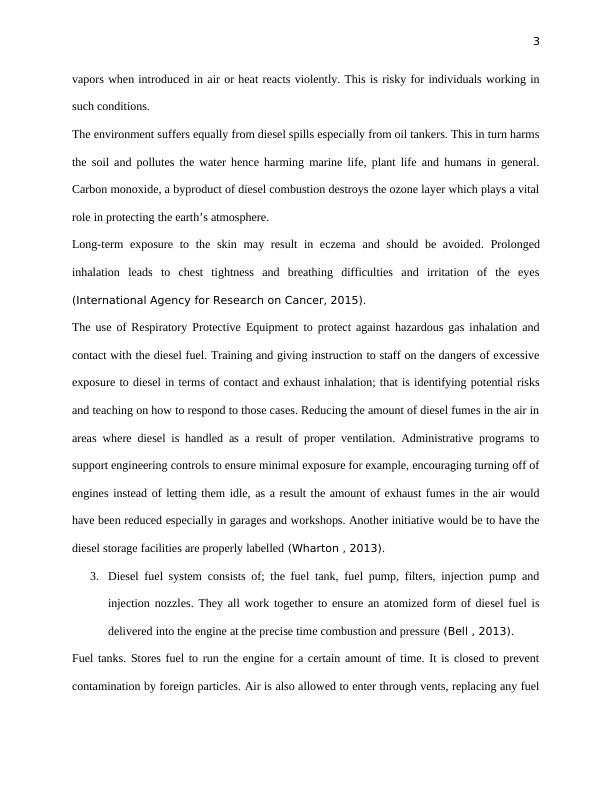National Environment Protection Research 2022
6 Pages1273 Words38 Views
Added on 2022-09-28
National Environment Protection Research 2022
Added on 2022-09-28
ShareRelated Documents
Running Head: AUR40816 1
AUR8016
Student’s name
University Affiliation
AUR8016
Student’s name
University Affiliation

2
1. Testing procedure for diesel systems as outlined by the national Environment Protection
(Diesel Vehicle emission) Measure (Denton , 2016).
The test done in a dynamometer to the fuel present in the tank during vehicle testing is as
follows.
Phase A; B; A-B: After the engine system idles, Select low gear and let it run for around 60
seconds
Phase B–C: Rapidly accelerate through gears until you achieve a speed of 80 km/h.
Phase C–D: Stop the vehicle by breaking.
Phase D-E: After the engine rests for a while, Select low gear and run it for another 60 seconds
Phase E-F: Accelerate rapidly until a speed of to 80 km/h is achieved.
Phase F-G: halt the engine by braking.
Phase G-H: Again, after the engine system rests, select low gear and run for 60 seconds.
Phase H-I: Accelerate rapidly until a speed of to 80 km/h is achieved.
Phase I-J: For about 60 seconds maintain the speed of 80 km/h.
Phase J: This completes the test. Reduce the speed and leave the vehicle engine idle.
2. Dangers of working with diesel.
Many mechanical devices are powered by diesel engines, they include Lorries, pick-up trucks,
buses among others, farm machinery and construction equipment are also powered by such
engines. The operation of all these machinery and equipment provide exposure to exhaust fumes
and sometimes in various workplaces it requires the operators to come in contact with diesel.
Diesel is a flammable substance and when brought in contact with a flame will ignite
spontaneously and therefore it is a fire hazard (Bennet , 2009). When exposed to temperatures
equal to or above 61 °C which is the flash point or self-ignition temperatures it ignites. Diesel
1. Testing procedure for diesel systems as outlined by the national Environment Protection
(Diesel Vehicle emission) Measure (Denton , 2016).
The test done in a dynamometer to the fuel present in the tank during vehicle testing is as
follows.
Phase A; B; A-B: After the engine system idles, Select low gear and let it run for around 60
seconds
Phase B–C: Rapidly accelerate through gears until you achieve a speed of 80 km/h.
Phase C–D: Stop the vehicle by breaking.
Phase D-E: After the engine rests for a while, Select low gear and run it for another 60 seconds
Phase E-F: Accelerate rapidly until a speed of to 80 km/h is achieved.
Phase F-G: halt the engine by braking.
Phase G-H: Again, after the engine system rests, select low gear and run for 60 seconds.
Phase H-I: Accelerate rapidly until a speed of to 80 km/h is achieved.
Phase I-J: For about 60 seconds maintain the speed of 80 km/h.
Phase J: This completes the test. Reduce the speed and leave the vehicle engine idle.
2. Dangers of working with diesel.
Many mechanical devices are powered by diesel engines, they include Lorries, pick-up trucks,
buses among others, farm machinery and construction equipment are also powered by such
engines. The operation of all these machinery and equipment provide exposure to exhaust fumes
and sometimes in various workplaces it requires the operators to come in contact with diesel.
Diesel is a flammable substance and when brought in contact with a flame will ignite
spontaneously and therefore it is a fire hazard (Bennet , 2009). When exposed to temperatures
equal to or above 61 °C which is the flash point or self-ignition temperatures it ignites. Diesel

3
vapors when introduced in air or heat reacts violently. This is risky for individuals working in
such conditions.
The environment suffers equally from diesel spills especially from oil tankers. This in turn harms
the soil and pollutes the water hence harming marine life, plant life and humans in general.
Carbon monoxide, a byproduct of diesel combustion destroys the ozone layer which plays a vital
role in protecting the earth’s atmosphere.
Long-term exposure to the skin may result in eczema and should be avoided. Prolonged
inhalation leads to chest tightness and breathing difficulties and irritation of the eyes
(International Agency for Research on Cancer, 2015).
The use of Respiratory Protective Equipment to protect against hazardous gas inhalation and
contact with the diesel fuel. Training and giving instruction to staff on the dangers of excessive
exposure to diesel in terms of contact and exhaust inhalation; that is identifying potential risks
and teaching on how to respond to those cases. Reducing the amount of diesel fumes in the air in
areas where diesel is handled as a result of proper ventilation. Administrative programs to
support engineering controls to ensure minimal exposure for example, encouraging turning off of
engines instead of letting them idle, as a result the amount of exhaust fumes in the air would
have been reduced especially in garages and workshops. Another initiative would be to have the
diesel storage facilities are properly labelled (Wharton , 2013).
3. Diesel fuel system consists of; the fuel tank, fuel pump, filters, injection pump and
injection nozzles. They all work together to ensure an atomized form of diesel fuel is
delivered into the engine at the precise time combustion and pressure (Bell , 2013).
Fuel tanks. Stores fuel to run the engine for a certain amount of time. It is closed to prevent
contamination by foreign particles. Air is also allowed to enter through vents, replacing any fuel
vapors when introduced in air or heat reacts violently. This is risky for individuals working in
such conditions.
The environment suffers equally from diesel spills especially from oil tankers. This in turn harms
the soil and pollutes the water hence harming marine life, plant life and humans in general.
Carbon monoxide, a byproduct of diesel combustion destroys the ozone layer which plays a vital
role in protecting the earth’s atmosphere.
Long-term exposure to the skin may result in eczema and should be avoided. Prolonged
inhalation leads to chest tightness and breathing difficulties and irritation of the eyes
(International Agency for Research on Cancer, 2015).
The use of Respiratory Protective Equipment to protect against hazardous gas inhalation and
contact with the diesel fuel. Training and giving instruction to staff on the dangers of excessive
exposure to diesel in terms of contact and exhaust inhalation; that is identifying potential risks
and teaching on how to respond to those cases. Reducing the amount of diesel fumes in the air in
areas where diesel is handled as a result of proper ventilation. Administrative programs to
support engineering controls to ensure minimal exposure for example, encouraging turning off of
engines instead of letting them idle, as a result the amount of exhaust fumes in the air would
have been reduced especially in garages and workshops. Another initiative would be to have the
diesel storage facilities are properly labelled (Wharton , 2013).
3. Diesel fuel system consists of; the fuel tank, fuel pump, filters, injection pump and
injection nozzles. They all work together to ensure an atomized form of diesel fuel is
delivered into the engine at the precise time combustion and pressure (Bell , 2013).
Fuel tanks. Stores fuel to run the engine for a certain amount of time. It is closed to prevent
contamination by foreign particles. Air is also allowed to enter through vents, replacing any fuel

End of preview
Want to access all the pages? Upload your documents or become a member.
